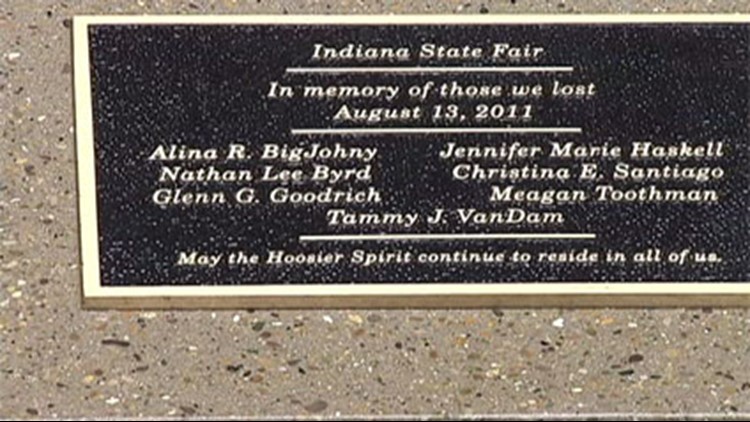13 Investigates gives you the first look into new national guidelines to keep people safe at outdoor structures and entertainment venues.
The Event Safety Guide was written in part as a result of the Indiana State Fair stage rigging collapse on August 13, 2011, and other incidents that put concert-goers in danger.
Seven people were killed before a Sugarland concert at the Indiana State Fair. Now that night could impact entertainment events across the nation.
"We went to a Carrie Underwood concert. She has a floating stage, and guess who was looking up?" asked Sue Humphrey of Indianapolis. "I wonder if the wires are okay? I wonder how many people would get hurt if it would fall?" she remembers thinking as she watched the stage suspended from wires over the audience.
There's a good reason for her concern.
It's been 18 months to the day since Humphrey's world came crashing down.
Her teenage son Bradley suffered permanent paralysis from the stage rigging collapse at the Indiana State Fair.
"That's what you think of now instead of enjoying the concert. You think of safety issues," said Humphrey.
Last April, world-wide representatives from the entertainment industry came to Indianapolis to begin a push for unified safety standards in the United States.
"The pain that was felt here in Indianapolis was shared around the world," said Tim Roberts, during that visit to the Indiana Government Center. Robert helped develop the Event Safety Guide in the United Kingdom.
Now for the first time, the so-called "purple guide" used in the United Kingdom has an Amercanized version under review by the entertainment industry nationwide.
13 Investigates got a sneak peek.
"This is a major undertaking. This covers everything from fire protection to crowd control to weather issues," said Safety Consultant and former Assistant Labor Commissioner Jeff Carter. Carter is among more than half a dozen Indiana experts weighing in on the guidelines that call for: site visits, construction drawings and calculations to determine proper loads and certified inspections.
At the time of the rigging collapse, Carter said there was no one place that provided clear industry standards.
"I think the whole industry had a bit of a wake-up call," said Carter. "The shows got more sophisticated, and maybe the safety didn't quite keep up with it," he explained.
Indiana has helped to rewrite the book on weather preparedness.
The official investigation into the State Fair tragedy found a lack of bracing and a three-second wind gust of 59 miles an hour toppled the stage.
The safety guide now says sustained winds at an even lower speeds should prompt an evacuation.
"Even 40 mile-an-hour winds - evacuate?" asked 13 Investigates.
"That's what they're saying," responded Carter.
Jim Digby, the Executive Director of the Event Safety Alliance behind the proposed guidelines, says the guidelines "will memorialize those who lost their lives in Indiana and prove to their families that we are doing all we can to make sure that it never happens again."
"It would be tragic not to use what happened as a catalyst. It would be tragic if the industry did not step up and course correct itself," he said by phone between travels Thursday.
"For me as a mom, as a parent, I'm glad these safety issues are coming into play. I feel a little bit better, but there's always that little, 'Oh my goodness, what's going to happen?,'" said Humphrey, who says her son is now looking to attend the Taylor Swift concert in April.
The U.S. Event Safety Guide represents best practices, but it's recommendations will NOT be mandatory. Digby says he believes the measures will get widespread support.
Carter says it provides a good framework for Indiana lawmakers who are looking to improve the temporary inspection requirements passed last year.
The 180-day review process will close in August. A finished guide is expected by this fall.



